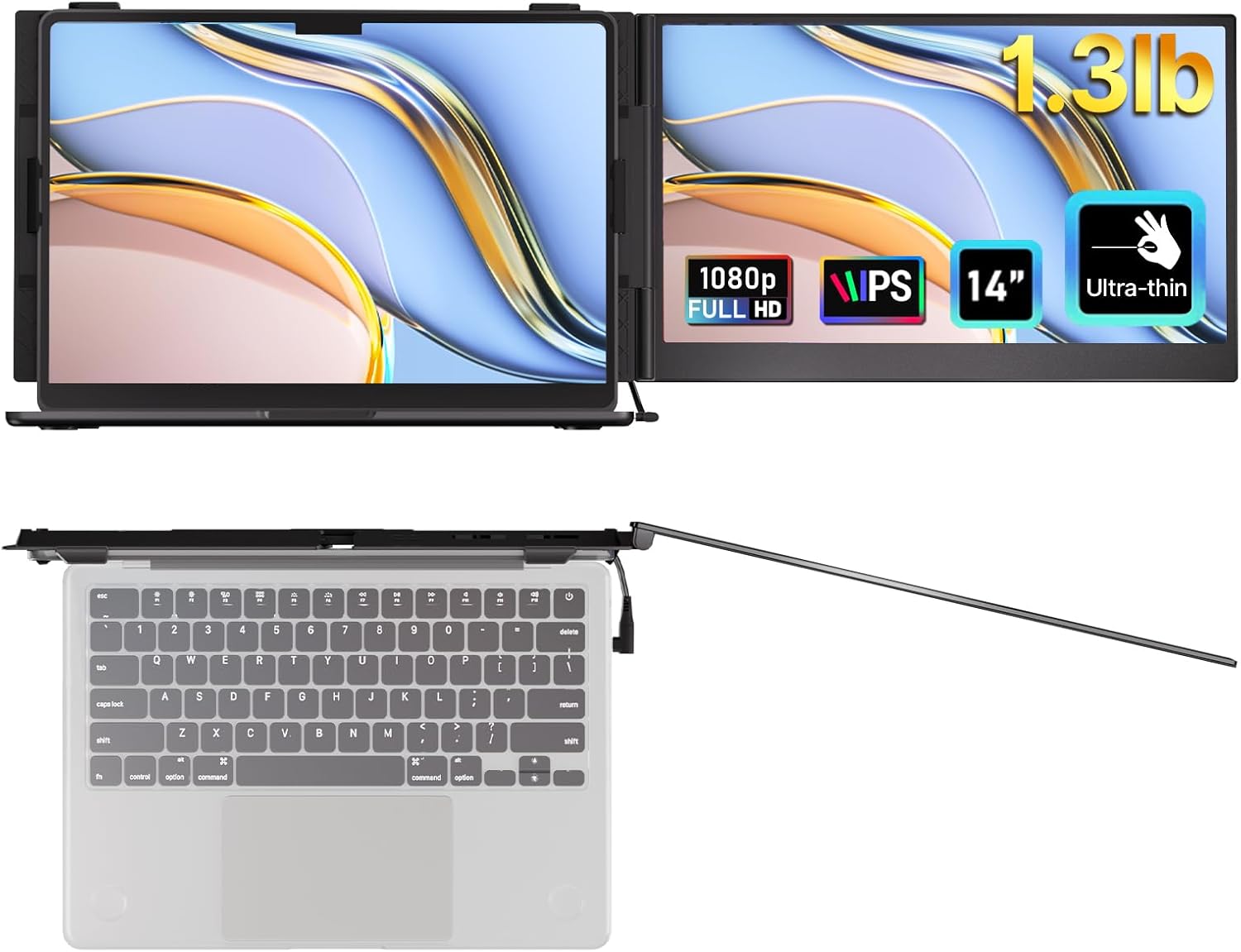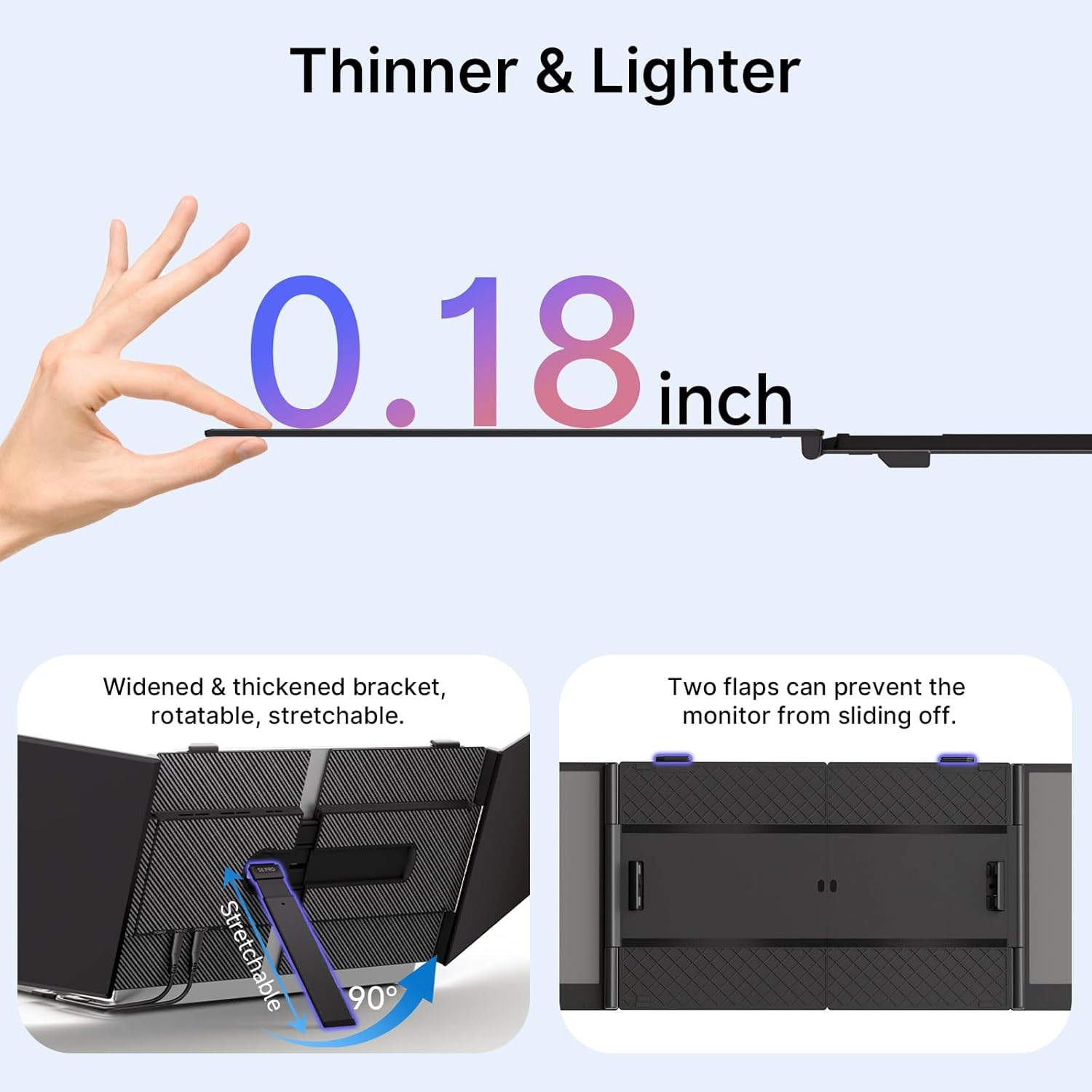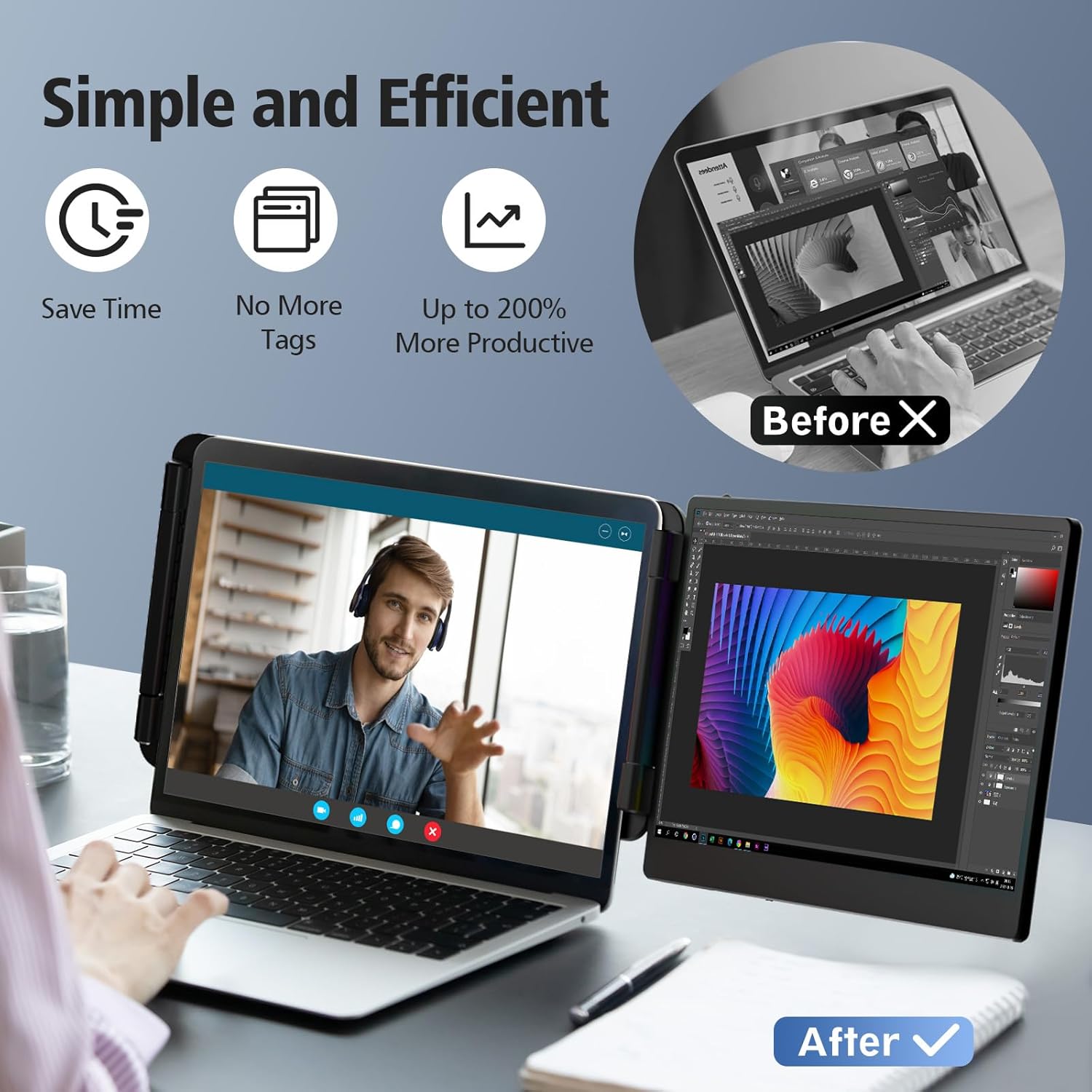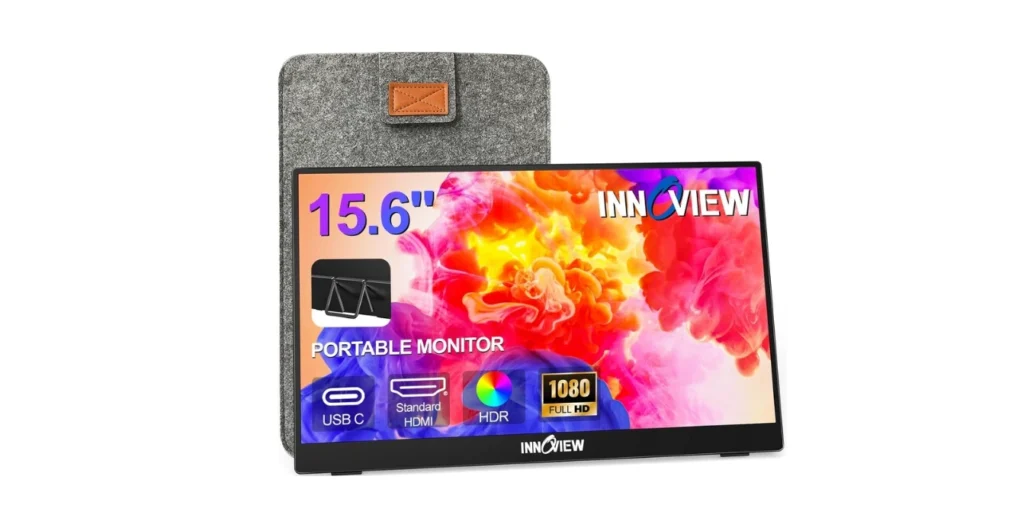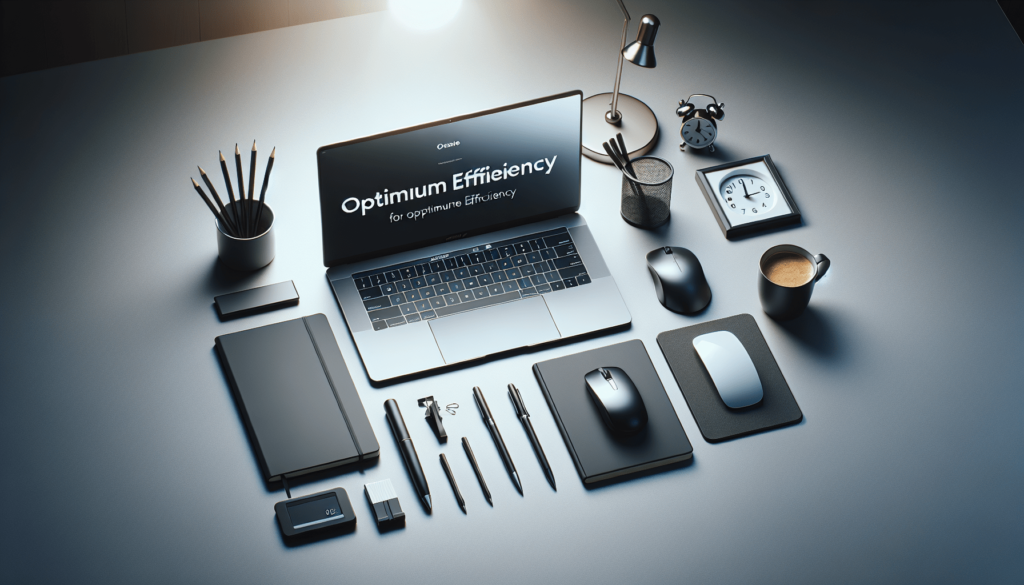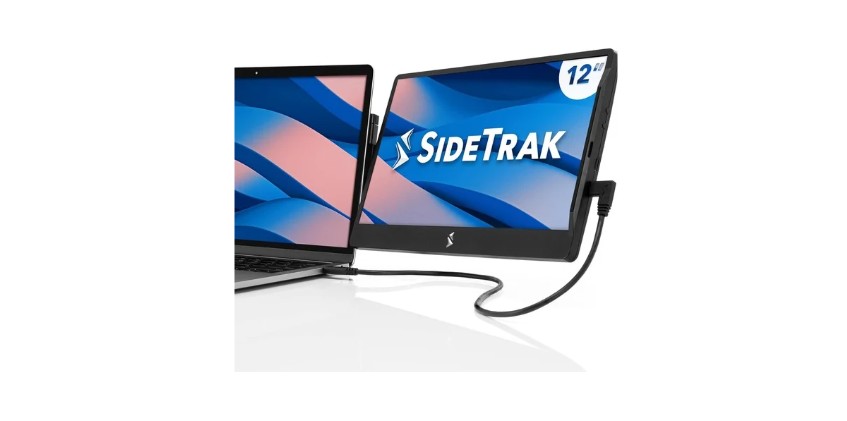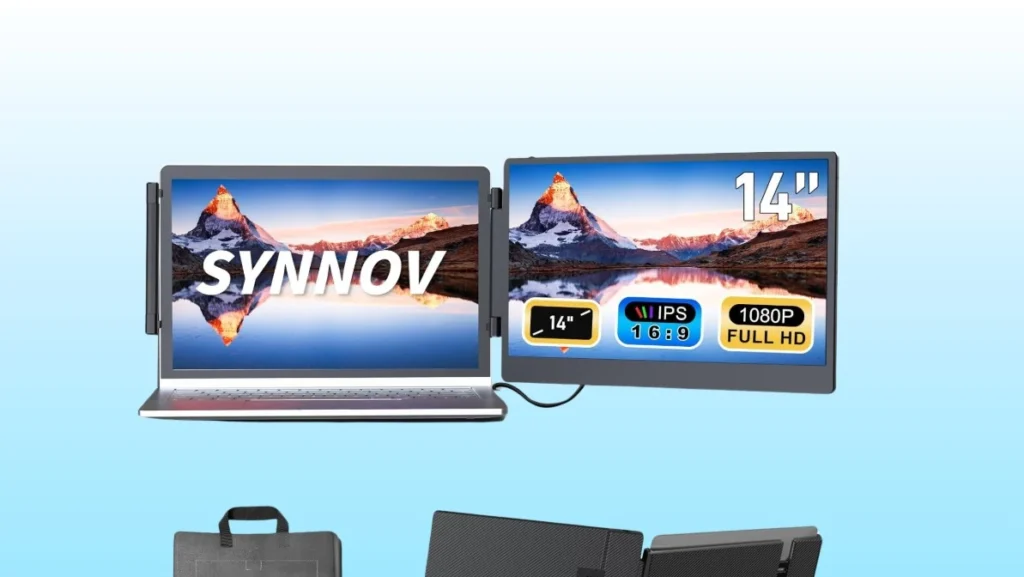Are we the only ones who fantasize about an extra screen the way other people fantasize about dessert?
Why We Wanted an Extra Screen in Our Bag
We’ve tried juggling tabs like circus performers and watched our productivity topple over like a wobbly stack of teacups. So when we met the Laptop Screen Extender – Ultra-Thin 1.3lbs 14″ FHD IPS Dual Portable Monitor Extension for Laptop, we saw the promise of sanity: a second display that goes anywhere our laptop goes, without turning our backpack into a gym membership.
Unboxing and First Impressions
We’re not proud of how quickly we tore into the packaging, but it’s hard to stay composed around thin, shiny objects that promise to make us 200% more efficient. The portable monitor is 0.25 inches thin and weighs 1.3 pounds, and both numbers feel wonderfully unreal in the hand.
The Ultra-Thin Build and Weight
At a quarter of an inch, this screen is thinner than our phone case and lighter than some hardback books we keep insisting we’ll finish. The ultra-thin profile means it slides into our bag with less friction than our conscience after skipping leg day.
The Materials and Sleeve
The aerospace-grade aluminum back earns its keep. It feels rigid without being heavy, and the finish laughs at micro-scratches. The included premium sleeve is the kind of small, practical kindness we wish more products had. We toss the extender into the sleeve, then into our bag, and then into the overhead bin—without fretting that it will emerge shaped like a croissant.
Quick Specs at a Glance
Sometimes we need the bullet points without the bullets. Here’s what we kept repeating to ourselves like a grocery list.
| Feature | What it is | Why it matters to us |
|---|---|---|
| Size | 14 inches | Big enough for spreadsheets, small enough to travel. |
| Resolution | 1080p Full HD | Crisp text and smooth video without draining our laptop’s soul. |
| Panel | IPS | Wide viewing angles; our neck thanks us. |
| Thickness | ~0.25 inches | Slides into our life without drama. |
| Weight | 1.3 lbs | Lighter than many tablets. |
| Build | Aerospace aluminum back | Tough, cool to the touch, and no flex. |
| Mount | Clamp for 13–17″ laptops, up to 0.25″ thick | Solid grip; no screen shimmy while we type. |
| Stand | Reinforced, foldable | Stays steady on café tables and questionable airport carpets. |
| Cables in box | USB-C to USB-C, USB-A to USB-C, HDMI to USB-C | We didn’t have to rummage for adapters. |
| Compatibility | Windows 10/11, macOS 10.15+, Android, Linux, Chrome OS | The big five (plus Linux) are covered. |
| Video standards | USB-C (DP Alt Mode), Thunderbolt 3/4, HDMI | Pick your poison; it likely works. |
| Warranty | 12 months | A year of breathing easier. |
Setup: Plug & Play Without the Ballet
We’ve done the driver dance before, and it’s always more samba than waltz. This time, the choreography is boring in the best possible way. If our laptop has USB-C with DisplayPort Alt Mode or Thunderbolt, one cable connects power and video. If not, HDMI handles video while USB powers the screen. That’s it.
One Cable or Two? What We Actually Used
- For modern laptops with Thunderbolt or USB-C video: we used the USB-C to USB-C cable. The monitor powered on; the screen lit up; we felt like engineers who’ve somehow slept.
- For older laptops with HDMI but no USB-C video: we used HDMI to USB-C for video and USB-A to USB-C for power. It’s still simple, just slightly more spaghetti on the desk.
What to Do If You See “No Signal”
The instructions are refreshingly honest: if you see “No Signal,” consider switching the HDMI cable path or use the USB-C with DP Alt Mode port on your laptop. We also checked:
- That our laptop’s USB-C port supports video (not all do).
- Windows Display Settings or macOS Displays arranged correctly.
- Power was supplied via USB when using HDMI.
Mounting: The Clamp and Stand Drama
Some portable monitors hunch like anxious turtles. This one struts. The clamp grips the laptop securely, and the stand fans out with confidence, keeping everything level like a calm person at a crowded baggage carousel.
Fit on Different Laptops
The clamp is made for most 13–17-inch laptops with lids up to 0.25 inches thick. Our ultrabook fit like it was tailor-made; our friend’s thicker gaming laptop did not. If your lid is chunkier than a quarter-inch, know that the clamp won’t make exceptions, no matter how nicely we ask it.
Stability on Sketchy Surfaces
We’ve used it on uneven café tables, a sunken couch armrest, a wobbly bar top, and one extremely spirited train ride. The reinforced stand and solid hinge design keep things steady. Typing doesn’t make the extender tremble like a frightened leaf, and the hinge resists unhelpful flopping.
Display Quality: 14″ FHD IPS in Real Life
An extra screen is only useful if it looks good and makes text readable. Here, the 1080p IPS panel earns its paychecks with sharp text, saturated but not cartoonish color, and viewing angles that let us slouch without distorting the image.
Brightness, Color, and Angles
- Text stays crisp at typical laptop viewing distances.
- IPS keeps colors consistent off-axis, which matters when the screen sits slightly off to the side.
- We didn’t find ourselves squinting or nudging the screen every few minutes to fight glare or washout beyond the usual café sunbeam problem.
Working Longer Without Eye Strain
We found we could read, write, and compare documents longer because we weren’t constantly tab-switching. The eye strain relief came from the workflow, not a magical coating. It’s just easier to look left than to chase a window that keeps hiding.
How We Actually Used It (and Liked It)
We test gadgets by living with them—coffee rings, crumbs, questionable Wi-Fi, the works. This one changed our day-to-day in a way we noticed immediately: more glancing, less toggling; more clarity, less “Where did that window go?”
Remote Work and Meetings
During video calls, we ran slides or notes on the extender while keeping faces and reactions on the main screen. It replaced that frantic mid-sentence scramble when someone says, “Next slide?” We also appreciated that moving chat to the side display freed our main screen for the work, not the commentary.
Coding, Writing, and Research
We kept code or writing on the laptop and documentation, browser tabs, or reference material on the extender. Two windows side by side feel like a miniature control room. It’s the closest we’ve come to calm while chasing a bug, a deadline, or a citation.
Spreadsheets and Finance
We dragged dashboards and transaction logs to the side, keeping formulas or charts on the main screen. Cross-referencing numbers stopped feeling like a memory test. If your job is basically moving data from one window to another, this screen pays for itself in un-gritted teeth.
Photo and Video on the Road
It’s not meant to be a color-grading reference monitor, but for sorting, comparing, and rough edits, it’s a fantastic assistant. We previewed footage on one screen and kept the timeline and tools on the other. Travel-friendly and competent is the sweet spot here.
Travel and Coffee Shop Life
We set up in tight spaces without trying to fold space-time. The stand footprint is compact, and the clamp doesn’t require an engineering degree. We did not become that person who spreads across three tables like an octopus with a to-do list.
Compatibility and OS Support
The extender is game to work with Windows, macOS, Android, Chrome OS, and Linux. We tried it on multiple machines and found the plug-and-play promise holds true, with a few predictable quirks if we chose the wrong cable or port.
Windows 10/11
- Use Windows + P to choose Extend or Duplicate.
- Arrange monitors in Settings > System > Display so your cursor crosses to the correct side.
- We set scaling to match our laptop for consistent text size.
macOS 10.15 and Later
- Open System Settings > Displays > Arrange to set positions.
- Toggle “Mirror Displays” off to extend.
- Hold Option while clicking “Scaled” if you want finer control of resolution.
Android (for Supported Devices)
- Phones and tablets that support video over USB-C (like DeX-capable devices) can drive the screen. We ran presentations and even a few streaming apps during a hotel-room tech rehearsal.
Linux and Chrome OS
- Linux detected the monitor cleanly (your desktop environment may vary).
- Chrome OS extended without drama; we shuffled windows as if it were a full desktop.
Which Cable Should We Use? A Quick Cheat Sheet
Sometimes the right cable is the difference between “Look at me, a functioning adult” and “Why is nothing happening?” Here’s the simple matrix we used.
| Your laptop/tablet port | Video support | Cable to try first | Power needed? | Notes |
|---|---|---|---|---|
| USB-C with DP Alt Mode | Yes | USB-C to USB-C | No | One cable does video + power. |
| Thunderbolt 3/4 | Yes | USB-C to USB-C | No | Fast, clean, and reliable. |
| HDMI only | Yes (HDMI) | HDMI to USB-C for video + USB-A to USB-C for power | Yes | Works great with two cables. |
| USB-C data only | No | HDMI to USB-C for video + USB-A to USB-C for power | Yes | Check your specs; not all USB-C carries video. |
| Older laptops with mini DisplayPort | Yes (DP) with adapter | miniDP-to-HDMI adapter + HDMI to USB-C + USB-A to USB-C for power | Yes | Adapters can be fussy; quality matters. |
If we saw “No Signal,” the fix was usually swapping cable roles or moving to the right USB-C port (some laptops hide their video-enabled USB-C on only one side).
Performance and Power Realities
We love magic, but we trust physics. The extender draws power from our laptop over USB-C or from a USB-A port if we’re using HDMI for video. That means our laptop battery will drain a bit faster. On a long flight, we either carry a power bank or scale down brightness to save juice.
Heat and Noise
The monitor stays cool and quiet. There’s no fan, just a slim design that dissipates heat efficiently. Even during longer sessions, we never worried about it getting toasty in a way that would unsettle our lap, our desk, or our sense of tranquility.
Controls That Don’t Annoy Us
Controls live on the edge where we can find them without digging. Adjusting brightness and basic picture settings is straightforward, and once we tuned it to our liking, we mostly forgot the buttons were there. That’s our favorite kind of UI: the one we leave alone.
Portability: What It’s Like to Actually Carry It
A portable monitor should not demand its own luggage. This one slips into the included sleeve and then into a medium-size backpack or messenger bag with zero drama. The aluminum back helps it resist the kind of bending pressure that ruins a day.
Bag Space and Everyday Carry
- Sleeve + monitor = roughly the footprint of a large magazine.
- Weight distribution stays reasonable; we didn’t feel lopsided.
- No guilt when we also pack a hardcover book for moral support.
Privacy and Security in Public Spaces
With two screens, we can tilt windows artfully to keep curious eyes guessing. For sensitive work, we dimmed the extender slightly and placed it at an angle that favored us and not the amateur detective at the next table.
The 200% Productivity Pitch: Our Real-World Take
Marketing math says we’ll become twice as efficient. We can’t promise your Slack backlog will melt, but we can say this: we got more done with less tab-toggling and fewer mental context switches. That is the kind of efficiency we feel—not just read about.
Multitasking Without Self-Sabotage
- Keep chat, reference, or notes on the side.
- Keep focus work on the main screen.
- Stop hiding windows behind windows behind existential dread.
Ergonomics Matter More Than We Think
We set the extender lower for reading and the laptop screen higher for typing; our neck thanked us. Small changes added up: fewer micro-adjustments, fewer squints, more time working instead of rearranging.
Limits and Edge Cases We Bumped Into
No product is perfect, and we like knowing the boundaries so we can avoid disappointment the way we avoid group texts with twelve participants.
Laptop Thickness
The clamp accommodates lids up to about 0.25 inches thick. If your laptop is heftier, the extender may not mount as intended. We tried attaching it to a bulky gaming notebook and had to retire from that ambition gracefully.
Battery Life
A second screen means more power draw. On battery, we plan accordingly: we reduce brightness, close unused apps, and carry a power bank or choose seats near outlets if we’re working long hours.
1080p vs. 4K Expectations
Full HD at 14 inches is sharp enough for text and media. If we’re doing color-critical print work or 4K video finishing, we save that for the studio. For travel and daily productivity, 1080p hits a sweet spot between clarity, speed, and efficiency.
Touchscreen Expectations
This is a standard display, not a touch panel. If we poke it absentmindedly, it just stares back, patient and unfazed.
Troubleshooting Tips That Saved Us Time
We’d rather prevent problems than perform tech exorcisms. These small habits kept things smooth.
- Use the right USB-C port: not all are video-capable.
- On macOS, arrange monitors so the cursor travels where your wrist expects.
- On Windows, check that the second display isn’t set to “Disconnect this display.”
- If HDMI is connected but the screen is dark, add the USB-A to USB-C power cable.
- Try a different cable if video flickers; cable quality is surprisingly critical.
- Update GPU drivers; it’s boring, and it helps.
A Few Favorite Workflows
We grew fond of certain layouts the way we grow fond of a reliable breakfast.
The Meeting Multitask
- Main: Zoom/Teams with gallery view.
- Extender: Agenda, notes, action items. We stayed present without turning the meeting into a scavenger hunt.
The Writer’s Nest
- Main: Draft in full screen.
- Extender: Research tabs, outline, style guide. We wrote more when the references were always visible.
The Developer’s Split
- Main: IDE.
- Extender: Documentation, logs, or local server preview. Less Alt+Tab, more actual problem-solving.
The Freelancer’s Ledger
- Main: Editing tool or design canvas.
- Extender: Client emails, reference images, or time tracker. We avoided losing the thread when messages trickled in.
A Comparison We Kept Making in Our Heads
We’ve tried other options:
- Traditional portable monitors with flappy cases: fine, but a bit wobbly.
- Larger 15.6-inch portables: nice at a desk, less fun on the move.
- Triple-screen contraptions: spectacular, but heavy and fussy for travel. This 14-inch, 1.3-pound, clamp-and-stand combo feels like the sweet spot for mobility and stability.
Care, Cleaning, and Not Breaking Things
We treat it like a good camera lens:
- Keep it in the sleeve when not in use.
- Wipe with a microfiber cloth instead of our shirt (we try).
- Don’t pack it loose with keys or cables that want to scratch.
- Detach gently; no need to channel our inner weightlifter.
Support, Warranty, and the Human Element
Each unit is tested before shipping, and there’s a 12-month warranty. If we needed help, the guidance said to reach out to AOKER Tech via the Add to Cart page. It’s reassuring to have a support path that isn’t a labyrinth of “have you tried turning it off and on again?” (Though yes, we did, and yes, it helped once.)
The For-Whom Question
We think this monitor suits:
- Remote workers who juggle meetings, notes, and reference materials.
- Students who need PDF + notes + lecture at once without tantrums.
- Creatives who want a clean preview space on the side.
- Consultants who live from airport chair to hotel desk and still need to get things done.
- Anyone who wants a second screen that fits into a normal bag and a normal day.
Maybe not ideal for:
- Laptops thicker than 0.25 inches (the clamp won’t fit properly).
- People who need 4K color-critical accuracy on the go.
- Anyone allergic to cables entirely (it’s two max, and usually one).
Our Favorite Little Luxuries
- The premium sleeve means one less errand.
- The hinge feels tuned, not twitchy.
- The IPS panel lets us shift around without losing the picture.
- USB-C one-cable setups feel like a small miracle every time.
Our Least Favorite Realities
- The clamp’s thickness limit is strict; measure your laptop lid first.
- Laptop battery life takes a hit, as expected.
- We occasionally had to remind ourselves which USB-C port on our laptop actually carries video.
A Practical Setup Recipe We Kept Repeating
- Step 1: Plug in USB-C to USB-C (if your laptop supports video over USB-C). If not, plug in HDMI to USB-C and add USB-A to USB-C for power.
- Step 2: Extend, don’t mirror, unless you’re presenting.
- Step 3: Arrange displays so the side monitor matches its physical location.
- Step 4: Set brightness to match your laptop for a seamless look.
- Step 5: Make the extender your “reference pane”: chat, docs, notes, preview. Keep the main screen for primary work.
Extra Credit: Making Two Screens Feel Like One Desk
- Match scaling between displays so text looks the same size on both.
- Choose a wallpaper that spans or complements both screens; it’s silly, and it helps focus.
- Keep your most-used windows pinned to the side; train your muscle memory to “look left for notes.”
- Use virtual desktops sparingly; the second display already gives your brain a map.
A Table of Everyday Tasks and How We Arranged Things
We kept returning to these configurations because they felt natural.
| Task | Main Screen | Extender Screen | Why it worked |
|---|---|---|---|
| Video meeting + notes | Gallery view | Agenda, notes, action items | No tab flipping mid-sentence. |
| Writing + research | Draft window | Browser tabs, outline | One glance keeps the thread. |
| Coding + docs | IDE | Docs, logs, server preview | Faster iteration. |
| Spreadsheet + source | Main sheet | Data source or email | Cut-and-paste sanity restored. |
| Light photo/video work | Timeline/tool panels | Preview window | Visual clarity while editing. |
| Travel planning | Booking site | Map, reference emails | Fewer mistakes when comparing. |
Living With It for Weeks: What Stuck
The honeymoon period ended, and we were still using it daily. That’s the highest praise we can give a gadget. If it returns to the shelf, it’s a toy. If it lives in the bag and gets pulled out at odd hours and odd locations, it’s a tool.
- We noticed fewer typos and mis-clicks while switching windows.
- We handled more messages without losing task focus.
- We stopped muttering “where did that go?” at inanimate objects.
Space and Surface Requirements
We work from narrow café counters, tiny apartment tables, and the occasional airline tray. The extender fits all of the above. The reinforced stand lets us set a comfortable angle without the display creeping downward as if it were shrugging at our ambition.
What About Gaming?
Let’s be honest: we tried. Casual titles and cloud gaming worked fine on hotel Wi-Fi that wasn’t allergic to fun. We wouldn’t buy this specifically as a gaming screen, but if your downtime includes a few rounds, it handles motion and color well enough to keep us entertained.
Safety, Sanity, and Good Habits
- Close the hinge and stow the monitor before moving to another table. We learned this the hard way with an ambitious latte.
- Keep cable runs tidy; a stray elbow at a small café is a force of chaos.
- If you use HDMI + USB-A, label the cables; future you will be grateful.
Why 14 Inches Feels “Just Right”
At 14 inches, we get more visible columns in spreadsheets, longer lines of code, and bigger previews without shrinking UI to ant-like proportions. It’s large enough to be useful and small enough to be agreeable about travel.
Our Verdict, Seasoned by Commutes and Coffee
If we measure usefulness by how often we groan when we forget it at home, this monitor scores high. It’s light, it’s thin, it’s sturdier than we expected, and it turns awkward workflows into ones that feel intentional.
- For frequent travelers and remote workers, it’s an easy yes.
- For students and freelancers, it punches above its weight.
- For anyone who has muttered “I just need one more screen,” it’s the kind of everyday upgrade that keeps paying off.
The Bottom Line We Keep Returning To
The Laptop Screen Extender – Ultra-Thin 1.3lbs 14″ FHD IPS Dual Portable Monitor Extension for Laptop does what it promises: adds a second screen anywhere, without fuss. It clamps on, stands up, and keeps pace across Windows, macOS, Android, Linux, and Chrome OS. It arrives with every cable we wanted and doesn’t make us install drivers or recite incantations.
We carry it because it makes our day quieter—the good kind of quiet, where we aren’t arguing with our software or our setup. It’s a polished, portable second display that respects our shoulders, our time, and our need to get things done without theatrics.
Warranty, Testing, and Getting Help
Each unit is tested before shipping, and there’s a 12-month warranty for peace of mind. If we needed assistance, we contacted AOKER Tech via the Add to Cart page and got a prompt response. That kind of support makes us more comfortable recommending it to colleagues who text us late at night with tech questions we pretend not to see.
Final Thought Before We Close the Laptop
We like products that behave like good travel companions: light packers, easy company, and happy to help. This screen does all three. It gives us the space we need without asking for much in return—just a port, a cable, and permission to make our workday less of a juggling act.
Disclosure: As an Amazon Associate, I earn from qualifying purchases.
